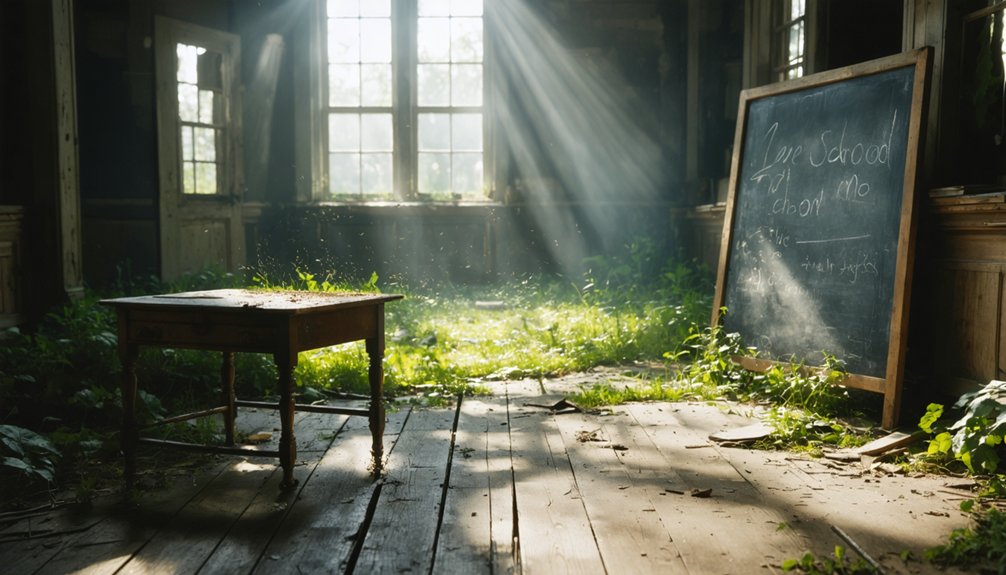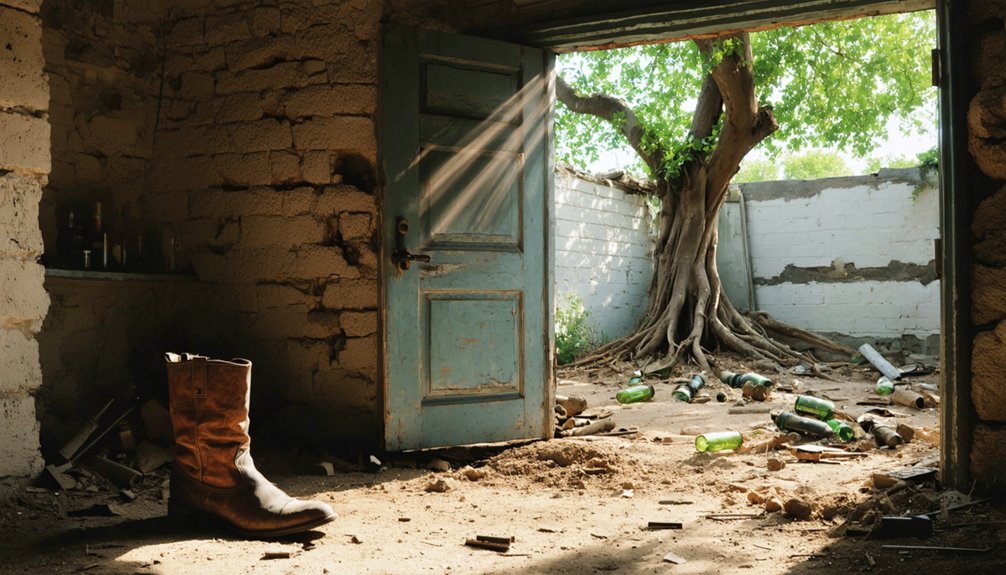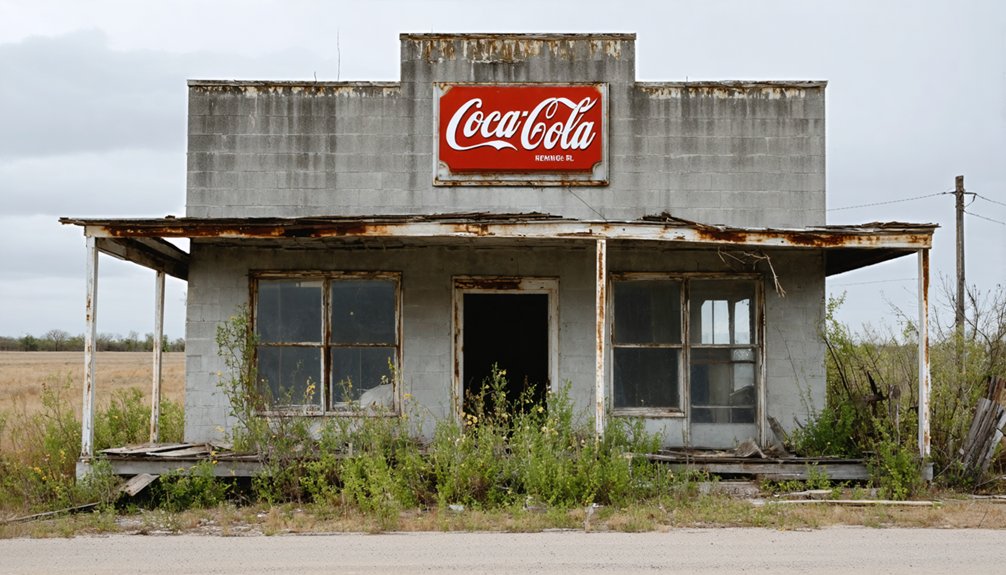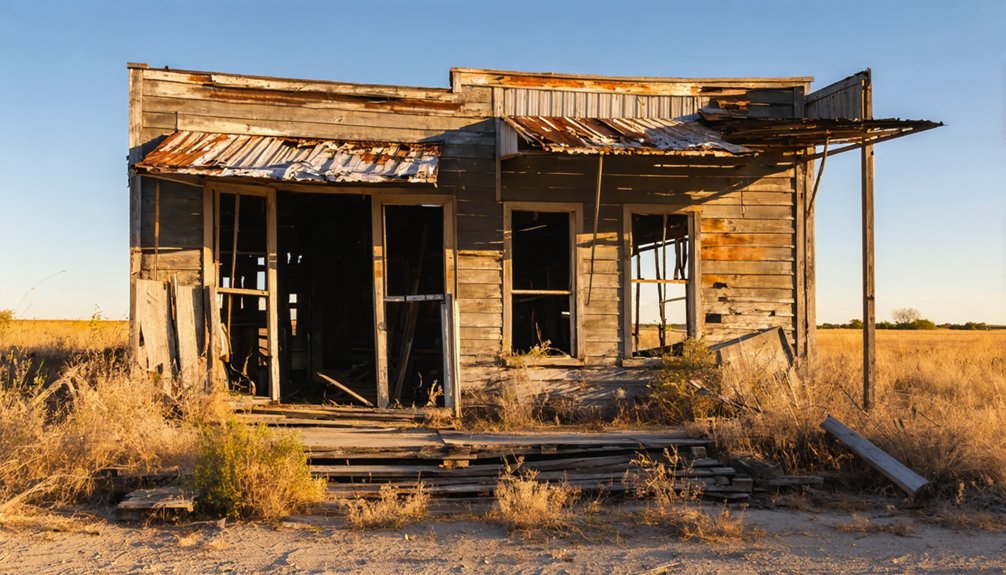You’ll find Rheingold’s remnants in Texas Hill Country, where German immigrants Jacob and Peter Gold established this settlement in 1852. Though cholera claimed the founders early on, their families built a thriving community centered around a schoolhouse, general store, and cotton gin. The town, renamed Gold in 1908, featured bilingual education and daily mail service until declining in the 1930s. Today, deteriorating structures and the historic schoolhouse reveal a rich German-Texan heritage waiting to be discovered.
Key Takeaways
- Rheingold, originally founded by German settlers Jacob and Peter Gold in 1852, was later renamed to Gold in 1908.
- The town’s economy centered around coal mining operations, which eventually declined, leading to its abandonment.
- A historic schoolhouse, built in 1873 from William Gold’s donated land, was designated as a National Historic Place in 2005.
- Railroad rerouting and agricultural changes forced younger generations to leave, contributing to the town’s transformation into a ghost town.
- Today, Rheingold consists mainly of deteriorating remnants and partially standing buildings, though some preservation efforts continue.
Origins of a German Settlement
While German immigration to Texas began flourishing in the 1830s through Austin’s colony, the organized settlement movement gained momentum in the 1840s with the formation of the Adelsverein.
The Adelsverein accelerated German settlement in Texas during the 1840s, building upon earlier immigration through Austin’s colony.
You’ll find that these early settlers faced significant challenges as they established new lives in Texas, driven by the promise of economic opportunities and social advancement.
The German immigrants quickly adapted their traditional farming methods to suit Texas’s unique environment.
When you examine their settlement patterns, you’ll notice they received both town lots and farming tracts, allowing them to build sustainable communities.
Despite harsh conditions, including disease outbreaks and poor soil quality, these pioneers demonstrated remarkable cultural adaptation.
The Fisher-Miller Land Grant provided crucial territory for European settlement in Central Texas.
They shifted from pure farming to include ranching activities, establishing resilient communities that would leave an indelible mark on Texas’s landscape. Immigrants from Hanover in 1846 established a notable settlement on the Matagorda Peninsula.
The Gold Family Legacy
After establishing themselves in the Texas Hill Country, brothers Jacob and Peter Gold founded the Rheingold community in 1852, though their lives were tragically cut short by cholera soon after arrival.
The area also saw the establishment of Rheingold School #22 in 1873, following the early education pattern of the region.
Their widows and sons carried on the Gold Family influence by maintaining ownership of essential local enterprises, including a general store, cotton gin, dance hall, blacksmith shop, and gasoline station.
The family’s commitment to community development shone through William Gold’s donation of land for the Rheingold School in 1873.
This legacy preservation continues today, as the school, listed on the National Register of Historic Places in 2005, serves as a community center.
The Gold family’s impact remained so significant that in 1908, when establishing a new post office, the town officially changed its name from Rheingold to Gold.
Early Community Life and Development
You’ll find that Rheingold’s early German settlers established a tight-knit community centered around the schoolhouse, which served as both an educational facility and gathering place.
The settlers initially focused on subsistence farming and livestock raising, working cooperatively to build essential infrastructure like wide streets that could accommodate freight wagons. Similar to how cotton and grain shipping flourished in other Texas towns, the settlers gradually expanded their agricultural operations.
Through careful town planning and shared labor, they transformed their settlement from basic log structures into a more permanent community with stone buildings and organized public spaces. Much like in Plemons Crossing, the development of the town was swift as more settlers arrived to establish businesses and homes.
German Settlers’ Daily Life
Living conditions in Rheingold’s early days reflected the stark realities of Texas Hill Country frontier life.
You’d have found the German settlers living in basic log cabins and wooden frame houses, where daily routines revolved around the demands of subsistence farming. As part of their cultural traditions, families worked together to cultivate corn, tend livestock, and hunt wild game – with bear meat becoming an essential food source.
You’d see the community gathering at dance halls and blacksmith shops, while their children attended German-language schools that preserved their heritage. The settlers regularly celebrated their culture with festive Schützenfeste rifle competitions. Many faced malarial fever outbreaks that devastated the population during the early settlement period.
When times got tough, you’d witness neighbors helping neighbors through food shortages and labor-intensive tasks, creating a tight-knit society bound by their shared immigrant experience and determination to survive the frontier’s challenges.
Founding Business and Services
When German immigrant brothers Jacob and Peter Gold established Rheingold in 1869, they laid the foundation for a modest but self-sufficient frontier community.
While you wouldn’t find many early businesses in town, the settlement quickly established essential community services centered around the Rheingold School, built in 1873 on two acres donated by William Gold. The school became the heart of local activities, featuring modern amenities like indoor heating and separate outhouses. Similar to other German settlements like Cave Creek, the community was primarily supported by farming families.
You’d have needed to travel to nearby Fredericksburg for your major trading needs, as Rheingold didn’t develop significant commercial enterprises.
However, the town’s carefully planned wide streets, modeled after Fredericksburg’s layout, made it easier for you to maneuver freight wagons and oxen teams, keeping the community connected to crucial trade routes.
Economic Growth and Infrastructure
The industrial heart of Rheingold beat solely to the rhythm of coal mining, initially operated by local companies before the Texas and Pacific Coal Company‘s takeover in the late 1880s.
Under new ownership, you’d find the town transformed into a tightly controlled operation, with barbed wire fences and armed guards restricting movement and commerce. Workers faced economic isolation through a system of scrip payments and company stores, forcing them into cycles of credit and debt. Like the Federal Reserve note, this local currency system created a paradoxical relationship between value and control.
The town’s infrastructure served only the mining industry’s needs, with company-built housing and minimal utilities inside the fenced perimeter. By 1897, the town expanded its industrial base with a brick-making plant that utilized local clay deposits.
This single-industry focus and lack of diversified development led to inevitable community decline once mining operations decreased. When mechanization and external coal sources emerged, Rheingold’s restricted economy couldn’t adapt, ultimately leading to its abandonment.
Education and Social Hub

Despite the mining company’s tight control over Rheingold’s economic life, education emerged as a beacon of community independence through the establishment of Rheingold School in 1873.
You’ll find that William Gold’s two-acre donation sparked a grassroots movement, with locals joining forces to build a modest log schoolhouse that later expanded. The school’s bilingual education in English and German preserved the area’s cultural heritage while preparing students for the future.
- Annual “Schulprüfung” examinations became celebrated community gatherings
- First teacher August Schuchard taught eight grades in both English and German
- Local families donated labor and materials to construct the schoolhouse
- School offered six months of free tuition before charging modest fees
- Building served as an essential community center even after 1949 consolidation
Postal Service History
Located at the heart of the growing settlement, Rheingold’s first post office opened its doors in 1878 with William Grobe serving as postmaster.
A pivotal year for Rheingold, 1878 marked the establishment of postal services under Postmaster William Grobe’s watchful eye.
You’d find this crucial hub near the general store, where daily mail delivery connected residents to the outside world. While specific postal routes weren’t documented, the service proved essential for the rural community‘s commerce and communication.
The post office’s story mirrors Rheingold’s own rise and decline. In 1907, mail service shifted to Willow City, and by 1908, a new post office reopened under the simplified name “Gold.”
This arrangement lasted until 1931, when Johnson City took over mail operations. Though no postal buildings survive today, these administrative changes mark key moments in Rheingold’s transformation from a bustling settlement to a ghost town.
Decline and Transformation

During the early 1900s, Rheingold’s transformation into a ghost town began through a perfect storm of economic and infrastructural challenges.
You’ll find that the town’s decline mirrored many Texas ghost towns of the era, where economic factors and shifting social dynamics played essential roles in its abandonment.
- Railroad rerouting devastated the local economy by isolating the community
- Agricultural changes made traditional farming methods less viable
- Family businesses shuttered as younger generations moved to urban areas
- Community cohesion eroded as social institutions closed their doors
- Infrastructure neglect led to deteriorating roads and buildings
The town’s transformation from a bustling community to a ghost town wasn’t sudden but rather a gradual process.
As families moved away and businesses closed, the remaining infrastructure fell into disrepair, leaving behind only remnants of its former liveliness.
Historical Preservation Efforts
You’ll find significant preservation work at Rheingold’s historic school buildings, where the Texas Historical Commission has recognized both the 1873 log structure and 1900 frame building for their maintained architectural integrity.
The Friends of Gillespie County Country Schools actively leads restoration projects to protect these educational landmarks through cleaning, repairs, and documentation efforts.
Local preservation groups also maintain the town’s cemetery sites, following state protocols for artifact conservation while creating heritage tourism opportunities through interpretive signage and driving trails.
School Building Restoration
Since its designation as a National Historic Place in 2005, the Rheingold schoolhouse has undergone careful restoration efforts that honor its German-Texan heritage while maintaining its role as a community center.
The school architecture showcases the evolution from a simple log cabin to a limestone structure, reflecting the resourcefulness of early settlers. Through dedicated community engagement, local families have preserved the building’s authentic features while adapting it for modern use.
- Original 12′ x 14′ log cabin core remains intact beneath stucco and wood siding
- Brick and mortar infill strengthens historical log construction
- 1920s limestone addition exemplifies German-Texan building techniques
- Community-built pavilion (1936-1938) stands as a symbol of local cooperation
- Traditional elements like separated facilities and wood stove maintain historical accuracy
Cemetery Site Protection
Located at the heart of historic Rheingold, the cemetery’s preservation represents a tribute to the community’s dedication to protecting its German-Texan heritage.
You’ll find systematic documentation efforts underway, with volunteers carefully recording gravemarkers row by row using non-invasive techniques to protect deteriorating inscriptions.
Cemetery conservation efforts focus on authentic restoration rather than replacement, ensuring any necessary repairs match original materials and designs.
Local groups coordinate regular maintenance through community fundraising and volunteer cleanup initiatives.
The Texas Historical Commission’s Cemetery Preservation Program provides essential technical guidance for grave marker preservation, helping protect both marked and unmarked burial sites.
Through these combined efforts, you’re witnessing the protection of Rheingold’s historic cemetery, maintaining its cultural significance while ensuring compliance with preservation standards.
Modern-Day Ghost Town Status

While there’s limited documented evidence about Rheingold’s current status as a ghost town in Texas, several economic and demographic indicators suggest the area has experienced significant decline.
Like many Texas ghost towns, you’ll find characteristic signs of abandonment and economic shifts that have shaped its current state.
- Structures may range from partially standing buildings to deteriorating remnants
- The area could present opportunities for historical tourism and exploration
- Local economic challenges mirror those of other ghost towns in Texas
- You’ll need to take into account complex property ownership and legal matters if interested in development
- Environmental factors and natural reclamation processes continue to shape the landscape
The site represents a snapshot of changing economic patterns in Texas, where industry shifts and population movements have left lasting impacts on once-thriving communities.
Frequently Asked Questions
What Natural Disasters or Events Contributed to Rheingold’s Decline?
You’ll find severe flood damage destroyed local infrastructure, while recurring drought impact devastated farming operations, making it impossible to sustain the region’s agricultural economy and maintain a viable community.
Are There Any Documented Paranormal Activities in Rheingold’s Abandoned Structures?
You won’t find documented ghost sightings or paranormal investigations in Rheingold’s ruins. While nearby West Texas ghost towns boast supernatural tales, this remote location hasn’t yielded any confirmed spectral encounters.
What Happened to the Descendants of the Original Gold Family?
You’ll find the Gold family descendants’ struggles led them to disperse from Rheingold after 1900, with no clear records tracking their family legacy beyond early 20th-century business and land holdings.
How Many People Were Buried in Rheingold’s Cemetery?
A staggering 90% were Hispanic miners and their families. You’ll find around 400-530 souls in this sacred ground, though cemetery records are incomplete due to weathered markers and makeshift burial rituals.
Did Any Famous Historical Figures Ever Visit Rheingold?
You won’t find records of any famous visitors in Rheingold’s history. The town’s historical significance centered on its German immigrant community, local businesses, and agricultural activities rather than celebrity appearances.
References
- https://mix941kmxj.com/the-strange-sad-story-of-a-texas-ghost-town-youll-never-visit/
- https://www.youtube.com/watch?v=phjUE19A8HM
- https://texashillcountry.com/hill-country-ghost-towns-explore/
- https://en.wikipedia.org/wiki/Rheingold_School_(Gillespie_County
- https://en.wikipedia.org/wiki/List_of_ghost_towns_in_Texas
- https://www.lonestartreasure.com/texas-ghost-towns-and-their-buried-riches/
- https://www.texasescapes.com/TexasHillCountryTowns/Gold-Texas.htm
- https://www.texasescapes.com/TOWNS/Texas-Ghost-Towns-3-Hill-Country.htm
- https://www.tshaonline.org/handbook/entries/german-settlement-tx
- https://en.wikipedia.org/wiki/Gillespie_County



